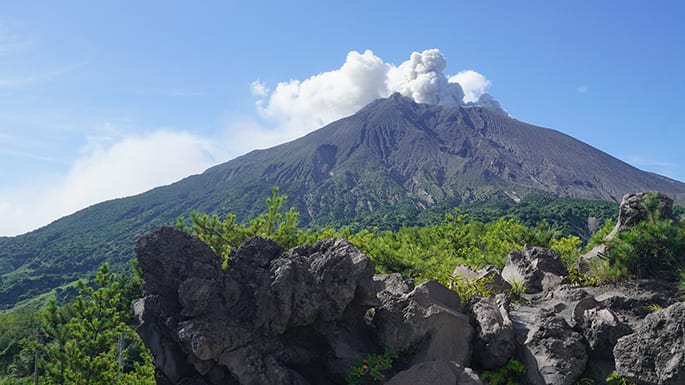The Land of the Rising Sun has many sides – discover two of them on this four-day break to Tokyo and Kagoshima.
The archipelago of Japan comprises close to 7,000 islands, which would take a lifetime to explore. So get started with this taster trip that mixes big-city excitement with bucolic charm, gathering up the best of Japanese culture, traditions and natural beauty. Split your time between Tokyo, the capital city, on Honshu, the largest island, and Kagoshima on Kyushu, in the south.
Day 1: A taste of Tokyo
Get a feel for the city’s historic heart with a ride on the vintage Toei Streetcar. The Tokyo Sakura Tram runs from Minowabashi Station in Arakawa, where remnants of “Old Tokyo” exist – narrow alleyways, old-fashioned shopping arcades and friendly izakaya (Japanese pubs) – to Waseda Station in Shinjuku. It takes about an hour to travel east to west, and there are 30 stations to detain the traveller en route – just as well, then, that the one-day ticket allows you to hop on and off as often as you please.
THE SUMIDA HOKUSAI MUSEUM
Take the Toei Oedo Line or JR Sobu Line to Ryogoku Station, in the Sumida district. Expect to bump into some seriously outsize gentlemen as you walk the streets there. Ryogoku is the centre of the sumo universe. It’s where the wrestlers live, train and eat their favourite hot-pot dishes (chanko nabe). They compete at the Ryogoku Kokugikan, their Wembley Stadium, several times a year.
Art-lovers will want to visit Sumida to see the work of Japan’s most celebrated artist, Katsushika Hokusai, at the museum dedicated to him there. His woodblock print Under the Wave off Kanagawa from the seriesThirty-Six Views of Mount Fuji is one of the world’s most beloved pictures.
As night falls, the city lights up, so tour it on the Sky Bus Tokyo-Odaiba Night Course, an open-topped double-decker bus. Tick off the Tokyo Tower and glamorous Ginza’s boutiques and restaurants, then treat yourself to a little shopping at the Aqua City mall in Odaiba, a futuristic development on a manmade island.
Day 2: Volcanic Kagoshima
Time to hit the seaside, but travelling overland to the city of Kagoshima would take at least 18 hours. Luckily, there are more than 20 flights a day between Tokyo Haneda Airport and Kagoshima Airport, and the journey takes under two hours. Keep an eye out for all 3,776 metres of Mount Fuji, the country’s highest mountain.
In Kagoshima, take the airport bus (about 50 minutes) to the city centre, then hop on the Sakurajima Ferry (about 15 minutes). It runs three to four times an hour, 24 hours a day, to Kirishima-Kinkowan National Park. Covering 36,000 hectares, the park is vast, and celebrated for its dramatic beauty. Mount Sakurajima, Japan’s most active volcano, is its star, but there are cuddlier landmarks, too: cedar woods, sandy beaches and azalea-covered mountain slopes.
The park is also home to many a hot spring, or onsen. The mineral-rich waters of the onsen are prized for their healing powers, which are believed to be good for a variety of physical ailments, from joint pain to skin complaints, and there’s nothing better than a soak in them to make you feel at one with the serene spirit of Japan.
Day 3: Spend time on the island
Take the Ibutama train to the beachside town of Ibusuki. For almost an hour, you’ll enjoy uninterrupted sea views from your window seat, and the train itself – small, perfectly formed and beautifully decorated – is like something out of a folk tale.
Look out for “Mystery Island”, the nickname of the uninhabited Chirin Island in Kinko Bay. From March to October, a sandbar causeway appears briefly each day, allowing visitors to cross to explore the island.
UNINHABITED CHIRIN ISLAND, KINKO BAY
Don’t pass up the chance to try a sand bath in Ibusuki. The town is known for its hot springs, but, courtesy of the volcanoes, the beach there also runs a temperature. Lie in a hole as an attendant piles warm sand on top of you. The Saraku Sand Bath Hall is right on the seashore. The health benefits of sand baths are reputed to be greater than those of a hot spring. Certainly there is something enormously soothing about being cocooned by the sand, listening to the roar of the waves and breathing in the sea air.
Day 4: Return to Tokyo
Feeling relaxed, enchanted and filled to the brim with a sense of zen, it’s time to head back to the city.
Fonte: kyushuandtokyo.org
Leggi anche: http://www.adhocnews.it/critics-accused-us-president-of-using-white-house-to-boost-personal-finances/
